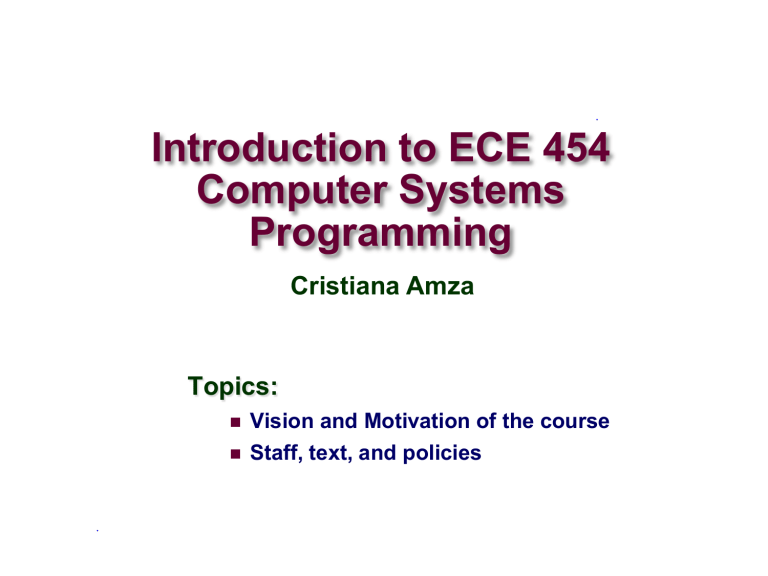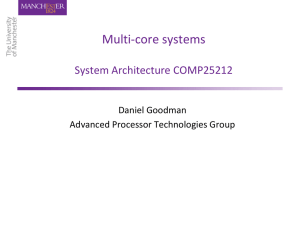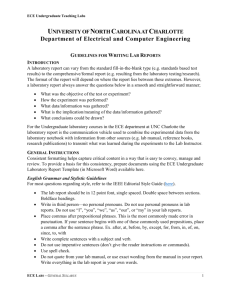Motivation - Computer Engineering Research Group

Introduction to ECE 454
Computer Systems
Programming
Cristiana Amza
Topics:
Vision and Motivation of the course
Staff, text, and policies
A bit about myself
Joined UofT in Oct 2003
Research in Distributed and Parallel Systems
Taught both ECE 419 and ECE 454 (2007-2009)
Previous ECE 454 offerings: 2007S, 2008S, 2009S and
F,2014F
More info on my Web page (see ECE 454 link under
Teaching)
– 2 –
Vision for the Course
ECE 454 – course I introduced in spring 2007. Here is why.
Software applications are more demanding than ever
E.g., games (frames per second)
Hardware is becoming more complex than ever
E.g.,: We need you to make the game run faster !
to understand the relationship between hardware and the performance of the software running on it
impact of memory hierarchy and cache coherence on your code
how to write code in an architecture-aware fashion
to exploit basic techniques for software optimization
– 3 –
Motivation for the Course
Exponential growth of hardware performance
known as Moore ’s law (e.g., processor speed)
Software writers could be lazy
waited for new generation of processors processor faster auto-magically speeds up code
Bad news: The free lunch is (almost over)
Processor frequency is not increasing any more
Software applications cannot rely on processors getting faster any more
How do we get more frames per second ?
– 4 –
Moore ’s Law
Gordon Moore (in 1965):
the complexity of semiconductor components had doubled each year since 1959
exponential growth!
– 5 –
this became known as Moore ’s Law
Intel Processor Performance per Cycle
(Olukotun 2005)
– 6 –
Important Role of Programmer
How should I write my programs, given that I have a good, optimizing compiler?
Don ’t: Smash Code into Oblivion
Hard to read, maintain, & assure correctness
Do:
Select best algorithm
Write code that ’s readable & maintainable
Procedures, recursion
Even though these factors can slow down code
Focus on Bottlenecks or Inner Loops (Profiling)
Do detailed optimizations where code will be executed repeatedly
Will get most performance gain here
– 7 –
Another New Path: Parallelism
Lower development cost:
combine processor cores
Tolerate defects:
disable any faulty processor
Processors P
C
P
C
Caches
C
Chip Multiprocessor (CMP)
many advantages
– 8 –
Modern Parallel Architectures
Proc
Proc Proc
Cache
Cache
Supercomputers
(large-scale multiprocessors)
Chip Multiprocessor
(CMP)
Simultaneous-
Multithreading
(SMT)
improvements through full/partial hw replication !
– 9 –
Improvements by Thread Parallelism
Threads
Proc
Proc Proc
Cache
Cache
Desktops
Supercomputers
Chip Multiprocessor
(CMP)
Simultaneous-
Multithreading
(SMT)
multithreading in every scale of machine!
– 10 –
Chip Multi-Processors (CMP)
IBM:
Power 5 (2-core)
Power 6 …
Intel:
Montecito (2-core Itanium)
Kentsfield (4core P4)…
AMD:
dual-core Opteron, Athlon X2
Quad-core Opteron
Sun:
UltraSparc T1: 32 cores
UltraSparc T2: 64 cores
Sony, Toshiba, IBM:
Cell:9 cores
… …
Power 5 dual-core Intel chip dual-core Opteron Cell
– 11 – abundant cores in Chip Multiprocessors
Hyperthreaded (SMT) Architectures
Intel: (Hyperthreading)
Xeon processors can do 2-way SMT
IBM Power5
4-processor CMP, each processor is 2-way SMT
Sun Niagara
8 cores each 2-way SMT
– 12 –
Course philosophy
I will teach you basic concepts and techniques for program optimization
For sequential code – optimizations for memory hierarchy
Parallel code and optimizations
You will apply them in short programming assignments
– 13 –
Logistics: Teaching staff
Instructor
Cristiana Amza (open door policy in addition to set office hours, usually right after lectures or by appointment)
Official Prof Office hours: Fri 1-3 p.m.
Five Official TA ’s: Xu Zhao (head TA), Yongle Zang, Peter Yi
Sun, Junji Zhi, Jack Yu Luo
Two volunteer TA ’s will be helping out as well
TA will always be in GB 243 for the middle hour of each PRA
The TA will announce when they are in the lab in person and/or on piazza
If you are in GB 251, please go to GB 243 if you need help
If nobody asks for help, TA may leave after one hour
– 14 –
These are the nominal office hours. Come talk to us anytime!
(Or phone or send email)
Recommended Textbook
Randal E. Bryant and David R. O ’Hallaron,
“Computer Systems: A Programmer’s Perspective”, Prentice
Hall 2003.
Textbook is not required
We will follow only parts of it somewhat closely (e.g., dynamic memory allocation)
The entire text-book is posted + what you need to read
However, I believe it is a useful book for the computer system programmer (if you have the money)
Order it on Amazon (probably better deal)
If you absolutely need me to, I can order some for you
– 15 –
Course Components
Lectures
Higher level concepts
Tutorials (one to three)
Held during lecture time, announced in advance
Introduction to profiling tools, other tools and skills for labs, clarifications
Labs
2 or 3 weeks each
Provide in-depth understanding of an aspect of system
Programming and measurement
Few lines of code, but need to put some thought into it
Some code given, profiling and optimizations required
– 16 –
Getting Help
Web
Portal – first releases of Lecture notes, assignments, annoucements
My Web page (under Teaching): condensed info
Syllabus, copies of lectures, assignments, exams, solutions
Piazza
Clarifications to assignments, general discussion
https://piazza.com/utoronto.ca/fall2015/ece454/home
Personal help policy
Professor: door open means come on in (no appt necessary), can also e-mail to set up appt.
TAs: See “TA schedule by week” on my Web page 454 menu, please e-mail the TA in charge first.
– 17 –
Policies: Assignments
Work groups
You have to work in groups of two for all labs !
form groups from now (working individually only by permission from instructor)
Hand-ins
Assignment release dates posted on Portal only
Due dates posted on Portal, hand-out, my Web page
at 11:59pm on specified due date.
Electronic hand-ins only (UG submit).
Submit procedure (will also be specified in lab handout)
submitece454f labno file-name on one of the UG machines.
– 18 –
Policies: Grading
Exams (65%)
Midterm (25%)
Final (40%)
All exams are closed book/notes.
Piazza answers and in-class 3-5 Quizzes (2%)
Labs (35%)
5 labs (15%, 20%, 25%, 20%, 20%)
Grading Characteristics
Labs are generally not heavyweight
(very) small percentage of each lab can be open-ended/reserved for student-driven ideas and optimizations
Lab scores should be high
Serious handicap if you don ’t hand a lab in
– 19 –
Facilities
Assignments will use UG Lab machines
Labs are GB 243 and GB 251
See course Web page for info
Please direct questions to your TAs
– 20 –
Cheating
Cheating is a serious offence, will be punished harshly
0 grade for assignment, potential for official letter in file.
What is cheating?
Sharing code: either by copying, retyping, looking at, or supplying a copy of a file.
What is NOT cheating?
Helping others use systems or tools.
Helping others with high-level design issues.
Helping others debug their code.
– 21 –
Memorable Quotes (historical)
“You should let people know what they are getting into.
This is a hard course ”. (Elena Kon, class of 2007).
– 22 –
The CSP Pledge (now ancient history)
I will not cheat,
I will not lie,
I will not cry about my mark.
I will not gripe,
I will not blame,
I will stop this senseless game.
– 23 –
The CSP Pledge (contd.)
I will work hard, participate,
And push my limits to create.
Because what I do matters,
Because who I am counts.
This is a core Engineering course.
These are the core Engineering values.
– 24 –





